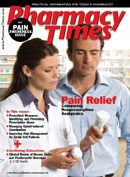Publication
Article
Pharmacy Times
Medication Safety: Auto-Injectors--A Shot in the Dark for Untrained Patients
Author(s):
Dr. Gaunt is a medication safety analyst and the editor of ISMP Medication Safety Alert! Community/Ambulatory Care Edition.
It is estimated that anaphylactic food reactions are responsible for 30,000 emergency department visits and cause 150 to 200 deaths per year in the United States.1 Death may occur within minutes of an anaphylactic food reaction; therefore, emergent treatment is needed. Because timely injection is crucial, epinephrine comes in autoinjectors that patients can carry with them.
Although epinephrine is an effective treatment, an anaphylactic reaction can be so severe and prolonged that 1 dose of epinephrine may not reverse the symptoms. Roughly 1 in 3 patients may have a reaction severe enough to require more than 1 dose.2 This is the basis of the Twinject (epinephrine) injector device, which contains 2 doses. The second dose can be prepared for administration through manipulation of the device after the first dose has been given if symptoms do not improve or if new symptoms appear within 10 minutes of the first dose.
The Institute for Safe Medication Practices has previously reported medication errors occurring due to the design of auto-injector devices like EpiPen (epinephrine). Recently, a patient’s mother raised concern about the design of the Twinject device. She had picked up the Twinject to be kept at her daughter’s school in the event of an emergency. The mother took the Twinject home and read the user manual for the device so that she would know how to administer the drug if needed. The mother reported that the design of the device was confusing. Even after becoming familiar with how the device was meant to be operated, she was afraid that in an emergency situation she, or the school nurses, would not be able to use the device properly.
The auto-injector may look like a pen, but it does not operate like one. Removing the caps from each end of the device (Figure) are the first steps in the instructions. The injector-pen must then be grasped in the middle of the barrel and pressed firmly against the lateral thigh to trigger the needle to enter the muscle. No thumb-depressing is needed. Once the needle has been triggered, the auto-injector must continue to be held against the thigh for 10 seconds. The second administration of Twinject requires a completely different technique from the first. To prepare the second dose, the patient or caregiver must unscrew and remove the rounded red tip, grab the blue plastic to pull the syringe out of the barrel, slide a yellow collar off the plunger without pulling up on the plunger, push the needle into the thigh, and depress the plunger down all the way.
Patient education and hands-on training are important aspects of managing anaphylaxis with injectable epinephrine. Manufacturers should proactively supply prescribers and pharmacists with patient education material and autoinjector trainer devices. Pharmacists and prescribers should provide handson training. Materials (eg, brochures, auto-injector trainers, videos) on how to use the devices should be given to the parent or patient to take home as well as to share with all caregivers. The manufacturers’ Web sites (www. twinject.com and www.epipen.com) should be used as learning vehicles.
The Twinject (top), which is able to deliver 2 doses, and the single-use EpiPen (bottom).
References
1. Sampson HA. Anaphylaxis and emergency treatment. Pediatrics. 2003;111(6):1601-1608.
2. Korenblat P, Lundie MJ, Dankner RE, et al. A retrospective study of epinephrine administration for anaphylaxis: how many doses are needed? Allergy Asthma Proc. 1999;20(6):383-386.







